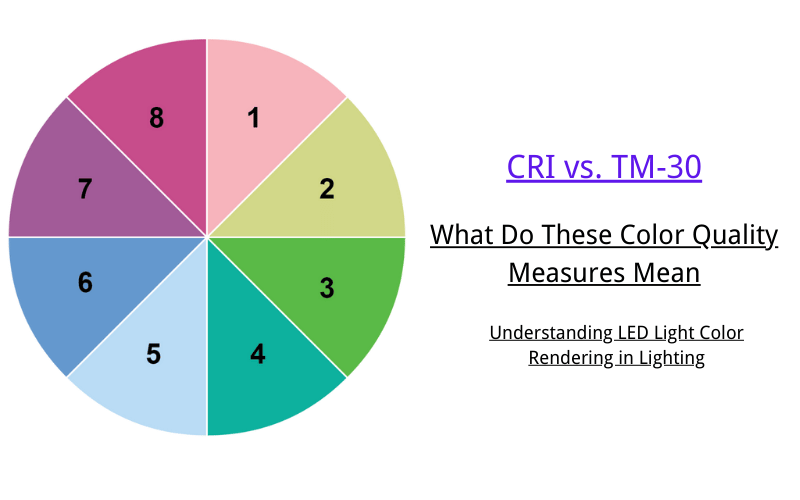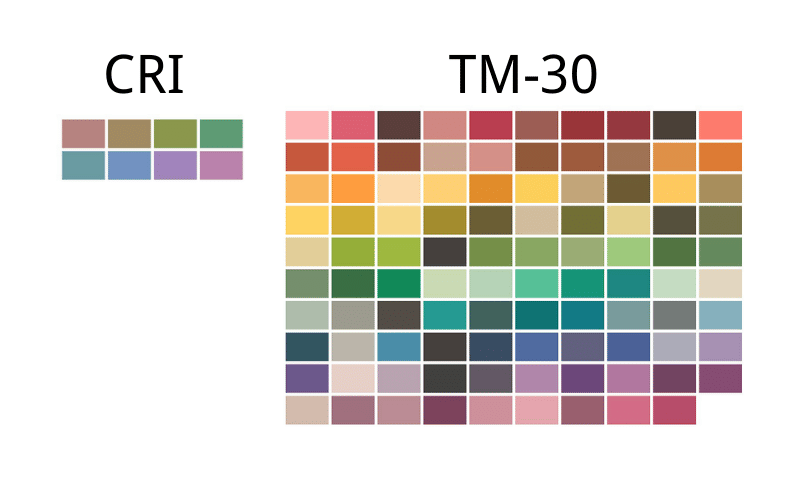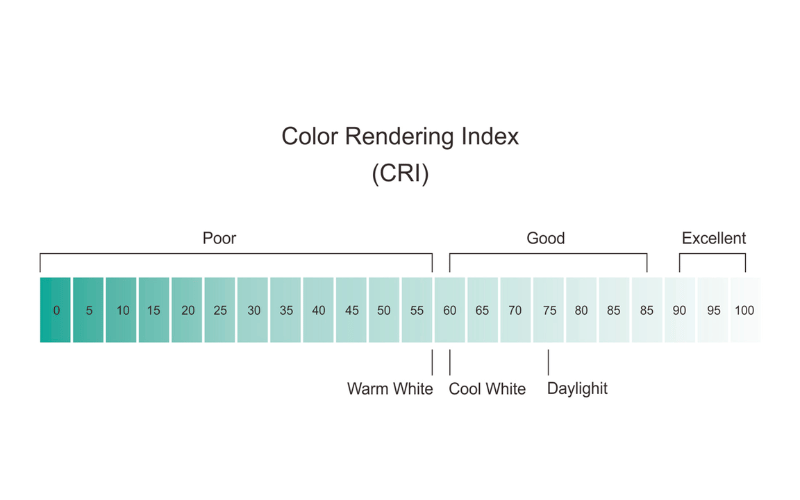Table of Contents
ToggleIntroduction to Color Rendering
Definition of Color Rendering
Color rendering is the capacity of an artificial light source to convey the spectral properties of an illuminated surface such that the perceived colors closely match their appearance under an ideal time of clear sunlight. This capacity evaluates how luminance is distributed across the visible spectrum, thereby ensuring that the natural texture, chroma, and hue of an object are preserved. Color accuracy is paramount in any context where hue identification can influence perception, such as merchandising environments, museum display halls, and medical examination settings.
Relevance of Color Rendering in Practical Lighting Design
Reliable color rendering contributes to visual quality and functional safety across a wide range of professional and consumer applications. Within a retail context, for instance, well-rendered merchandise assumes a more attractive visual character, subsequently affecting the formation of consumer preferences; in hospital or laboratory zones, authentic discrimination between otherwise similar colors may determine the validity of a diagnostic step; finally, compromised spectral continuity may trigger viewer discomfort or provoke errors in color-critical tasks. Thus, the integration of a light source that delivers superior color fidelity is both an aesthetic necessity and an ergonomic requirement.
Fundamental Rendering Metrics: CRI and TM-30
Two interrelated but distinct metrics quantitatively characterizes color rendering:
- CRI (Color Rendering Index): CRI delivers an ordinal assessment of a source’s ability to match a standard set of spectral comparisons, reported as a score between 0 and 100, wherein higher scores signify closer compliance to natural daylight, an 80 score generally satisfying the majority of task-based environments, and a score in the 90-range preferred where fine chromatic adjustments are deemed essential.
- TM-30: TM-30 extends the CRI framework by resolving spectral fidelity to both hue shift and saturation,—characteristics gauged through broader spectrum bins—that produce a two-dimensional evaluation reflecting both chromatic discrimination and viewer preference likelihood in luminance.
TM-30 (Technical Memorandum 30): TM-30 presents a sophisticated and layered approach to quantifying color rendering. The procedure comprises two principal indices:
- Fidelity Index (Rf): Closely analogous to the conventional CRI, this component quantifies the degree to which surface colors are reproduced with fidelity.
- Gamut Index (Rg): This metric examines color saturation, capturing the extent to which hues are rendered with increased or decreased vividness when illuminated by the source.
Because TM-30 delivers a thorough and multi-dimensional appraisal, it has become the standard reference in contemporary lighting design inquiries.
Understanding CRI (Color Rendering Index)
Definition and History of CRI
The Color Rendering Index (CRI) quantifies the fidelity with which a given light source reproduces the spectral qualities of an illuminated object in comparison to a specified reference illumination, typically an idealized daylight. This quantification adopts a cardinal scoring system, extending from 0 to 100, in which ascending scores signify progressively faithful color reproduction. The index was formalized during the 1960s by the International Commission on Illumination (CIE) and was subsequently endorsed as an internationally standardized evaluative tool. Within the illumination engineering domain, CRI rapidly established itself as a normative reference, particularly in sectors—such as retail merchandising, visual artworks, and clinical environments—where faithful color rendering is a discrete or tacit evaluative imperative.
How CRI is Measured
The CRI determination protocol establishes a comparison between the color appearance of eight standard color samples—selected to span the color gamut—under the candidate source and under an appropriate spectral reference that shares color temperature with that source. The methodology derives a series of chromatic discrepancies, which are then operator-moderated into a mean asymmetrical metric. Optimal performance, indicated by an index of 100, characterizes a circumstance in which discrepancies under the candidate source parallel those under the reference. The index is implicitly constrained, however, by its dependence on eight pastel samples that collectively neglect the appearance of highly saturated or specifically-vibrant samples. This shortcoming has engendered modifications, the most prominent of which is the TM-30 metric, concurrently retaining the CRI legacy while enlarging the fidelity evaluative framework.
High CRI lighting, defined as luminaire output with a Color Rendering Index of 90 or greater, confers numerous, measurable benefits:
- Highly Accurate Color Representation: A CRI of at least 90 minimizes distortions in the perception of hue, chroma, and texture, which is essential in environments such as art galleries, photography studios, and branded retail displays where fidelity to original color is paramount.
- Reduced Visual Fatigue: Lighting systems designed to render color accurately diminish the disparity between visual memory and stimulus, thereby lowering eye strain and augmenting comfort in settings requiring sustained observation, such as laboratories or clinical diagnostics.
- Enhanced Spatial Aesthetics: Fixtures with elevated CRI impart a sense of dynamism and warmth to surfaces, rendering walls, furniture, and architectural details more inviting and reducing the perceptual lifelessness often associated with lower-quality sources.
- Augmented Operational Efficiency: In professional contexts—graphic design, digital proofing, or radiologic imaging—exact color reproduction is a precondition for accuracy. Consequently, environments outfitted with high-CRI sources facilitate greater throughput and lower error rates.
By instituting a high CRI lighting strategy, one can construct environments that synthesize functional rigour with perceptual enrichment.
Exploring TM-30
Introduction to TM-30 and Its Development
Technical Memorandum 30 (TM-30) represents an evolution of color-rendering assessment, formally introduced by the Illuminating Engineering Society (IES) in 2015 as a purpose-built successor to the Color Rendering Index (CRI). Its architectural design responds to the limitations inherent in legacy evaluations, which depend on an abbreviated panel of color samples and legacy experimental paradigms. TM-30, by contrast, synthesizes high-dimensional color space data through contemporary spectral and photometric modeling, permitting richer and more granular characterization of the perceptual impact of electric light sources. Consequently, the metric is now embedded in the workflows of architectural and systems-level lighting design, aiding practitioners in the simultaneous pursuit of color fidelity and energy economy.\
TM-30-15 Metric Explained
The TM-30-15 evaluation framework derives its rendering diagnosis from two tightly-integrated indices. First, the Fidelity Index (R f ) interrogates perceptual congruency by measuring the degree to which a light source replicates the chromatic values of a predetermined reference. By applying a comprehensive set of 99 color samples, the fidelity assessment achieves the increased statistical power and lower uncertainty associated with large sample methodologies. A theoretical upper limit of 100 signifies perfect reproduction. Complementing R f , the Gamut Index (R g ) quantifies chromatic stimulus by evaluating changes to color saturation introduced by the evaluated source. R g reports relative deviation from a saturation norm; values exceeding 100 denote chromatic enhancement, values falling below 100 denote chromatic reduction, and a score equal to 100 indicates saturation invariance.
TM-30 enriches the color-rendering assessment process by offering clear graphical graphics, including color vector diagrams and hue-shift charts, allowing designers to assess at a glance how a given source alters color appearance in a lighting application. This granularity positions the standard as a vital resource for lighting system design, balancing chromatic fidelity and energy consumption.
Benefits of TM-30 Relative to CRI
TM-30 supersedes CRI by delivering a more nuanced and actionable evaluation of chromatic performance:
- Sample Scope: TM-30 includes 99 chromatic stimuli, versus CRI’s 8, supplying a more exhaustive characterization of color fidelity across the spectrum.
- Saturation Analysis: TM-30’s Gamut Index (Rg) quantifies chromatic saturation, offering the design team vital information regarding the intensity of hues under the proposed source.
- Visual Analytics: The program’s color vector overlays and associated graphics furnish designers with intuitive insights, a capability conspicuously absent from CRI.
- Contemporary Scope: TM-30’s framework recognizes the spectral properties and application contexts of emerging LED and OLED technologies, ensuring continued compatibility with current and future installations.
Despite CRI’s enduring popularity in contexts where rapid appraisal is sufficient, TM-30 is rapidly becoming the standard in projects demanding stringent chromatic fidelity and detailed evaluation.
Key Differences Between CRI and TM-30
Measurement Methods
The methodologies employed by CRI and TM-30 to appraise color rendering diverge appreciably. The CRI metric is derived from only eight pastel color samples, prescribing an overly narrow gamut that biases the analysis toward subdued hues. TM-30, by employing a cohort of 99 samples that span both pastel and high-saturation colorations, achieves a much more comprehensive spectral coverage. The consequent expansion renders TM-30 not only more resolute but, moreover, more germane to the color rendering of contemporary solid-state light sources such as LEDs. To augment the empirical framework, TM-30 also deploys refined mathematical models that simultaneously quantify color fidelity and saturation, thereby delivering an enriched, multidimensional portrait of the light source’s chromatic behaviour.
Color Quality Scale
While the Color Rendering Index (CRI) provides a single numerical value—ranging from 0 to 100—to represent a light source’s fidelity to a standard set of color samples, its singular focus on color accuracy limits its usefulness. CRI does not quantify aspects of color quality, such as saturation, that can materially affect the appearance of objects under light. The TM-30 method remedies this gap by defining two interrelated indices: the Fidelity Index (Rf) and the Gamut Index (Rg). Rf, analogous to CRI, gauges color accuracy, but TM-30 relies on a more extensive palette of samples, leading to finer fidelity assessment. Rg quantifies saturation by revealing whether specific color patches are rendered more intensely or more subdued. The simultaneous reporting of both indices permits a more nuanced characterization of color quality, meaning TM-30 is now the preferred standard when lighting performance is a concern.
Practical Implications in Lighting Design
The divergence between CRI and TM-30 is more than theoretical; it provokes practical consequences in the field of lighting design. First, TM-30 delivers a higher accuracy in rendering color, permitting professionals to ensure that hues are rendered with uniform dependence in applications where fidelity is vital, such as in retail merchandising, healthcare environments, or museum curation. Secondly, the availability of indices for both fidelity and saturation introduces a dimension of design discretion that CRI does not afford. Lighting professionals can therefore select or customize light sources not only to reproduce the correct hue but also to amplify color vibrancy for lively product displays or to sustain the subdued tonality of a naturally lit space.
- Enhanced Relevance for LED Sources: The TM-30 method explicitly incorporates the spectral and spatial properties typical of LED emitters, thereby ensuring that the rendered-quality evaluation aligns with the characteristics of contemporary solid-state lighting, unlike the CRI procedure, which originates from incandescent-based systems.
- Graphical Decision Support: TM-30 provides color-visualization tools, including color vector graphics and fidelity and saturation shift diagrams, that enable lighting designers to map anticipated color shifts directly onto the spectral sample, thereby translating design criteria into quantitative spectral adjustments with minimal interpretation error.
Although CRI continues to serve as a preliminary screening indicator, TM-30 supplies the necessary spectral detail and multi-dimensional fidelity assessment required for high-precision LED applications and complex color-critical environments.
| Aspect | CRI (Color Rendering Index) | TM-30 (Technical Memorandum 30) |
|---|---|---|
| Number of Color Samples | 8 pastel color samples | 99 color samples, including saturated and pastel hues |
| Metrics Provided | Single score (0-100) for color fidelity | Two indices: Fidelity Index (Rf) and Gamut Index (Rg) |
| Saturation Analysis | Does not measure saturation | Measures saturation changes with Rg |
| Graphical Tools | Not available | Provides color vector diagrams and hue-shift charts |
| Relevance to LED Technology | Designed for older incandescent-based systems | Specifically designed for modern LED and OLED technologies |
| Use Cases | Quick assessments for general lighting | Detailed evaluations for color-critical applications |
LED Lights and Their Color Rendering
Color Performance in LED Strip Lights
Because the illumination produced by LED strips is often employed in environments where color fidelity is critical, characterizing their output via standard photometric indices is a necessary step in design evaluation. Current practice in color rendering assessment employs two complementary metrics: the Color Rendering Index (CRI) and the TM-30-15 method. When both indices are applied in conjunction, design professionals obtain a comprehensive view of color fidelity that guides the specification of products for demanding visual environments.
Evaluative Methods
The Color Rendering Index affords designers a salient and readily correlated figure of merit, whilst the TM-30-15 method elaborates the spectral distribution of the source by generating a detailed color fidelity and gamut score, respectively. In typical assessment, CRI values exceeding 80 signify acceptable fidelity for general illumination. However, installations that mandate prevision of hue accuracy proportional to perceptual judgment, as in graphic-art studios or retail-display merchandising, generally require CRI values above 90 in conjunction with TM-30 fidelity scores that limit color-shift to ≤ 5, thereby ensuring the saturation and hue of the illuminated samples remains dependable and consistent in commercial practice.
The application of the TM-30 protocol provides a purpose-specific performance appraisal of LED strip fixtures by quantifying both color fidelity (Rf) and color saturation (Rg). By treating fidelity and saturation as discrete metrics, the protocol ascertains whether a given source intensively accentuates, neutrally renders, or subtly diminishes hues, thus nestling the assessment within a richer performance narrative. Accompanying these values, TM-30’s color vector graphic overlays graphically synthesize fidelity and saturation responses, enabling stakeholders to preview anticipated color modifications under exuberant application conditions.
Integrating TM-30 alongside CRI assessment effectively sharpens the evaluative prism, empowering design practitioners to gauge LED strip performance against the chromatic constraints and emotive goals of divergent application environments.
When selecting LED light sources, the intersection of color rendering quality and contextual exigency must be judiciously negotiated. The evaluative procedure comprises three determinant considerations:
- First, the criticality of the application must drive the performance benchmark. Ambient lighting within a conventional setting may permissibly bear a CRI exceeding 80, conversely, environments requiring the meticulous appraisal of color (e.g., galleries, retail merchandising zones, or clinical diagnostic lighting) must be supplied by sources exhibiting CRI values above 90 or by TM-30 sources presenting concurrent high Rf and Rg magnitudes.
- Second, the preferred color temperature must harmonize with the contextual tasks or moods prescribed within the space. Warm white values (2700K to 3000K) substantiate the domestic and hospitality lexicon, while cool white outputs (4000K to 5000K) underpin the precise and functional narrative expected within office, laboratory, or cognate environments.
- Quantify Saturation Requirements: Reference TM-30’s Gamut Index (Rg) to ascertain whether an increase in saturation is warranted for displaying vivid hues or whether a more balanced chromatic array is preferable for preserving lifelike color fidelity.
- Conduct In-Situ Evaluation: Prior to committing to a full installation, evaluate the chosen LED sources directly in the intended environment. This minimizes the risk of oversaturation or color-shift artifacts and confirms that the anticipated chromatic and luminous characteristics are realized.
By prioritizing these evaluations, lighting designers can confidently specify LED solutions that optimize both visual clarity and perceptual accuracy.
Frequently Asked Questions
Q: What range of Color Rendering Index can be expected from LED sources?
A: LED sources exhibit a Color Rendering Index (CRI) that generally lies between 70 and 100. Variants achieving a CRI of 90 or greater are categorized as high-fidelity sources, supplying a nearly complete representation of the visible spectrum. Such sources are advisable for retail merchandising, art exhibition, and similar contexts where precise color reproduction is essential.
Q: In what manner does TM-30 advance the assessment of color rendering?
A: TM-30 supersedes traditional CRI by employing a dual-index framework. The Fidelity Index (Rf) quantifies the degree to which a source preserves nominal color values, while the Gamut Index (Rg) gauges the degree of chromatic enhancement. The result is a dual lens permitting designers to select luminaires that concurrently achieve both fidelity of original hues and heightened chromatic vibrancy, as project goals demand.
Q: What role does color temperature play within the lighting design process?
A: Color temperature, expressed in Kelvin, is a pivotal parameter that governs both the spectral profile and the perceptual temperature of the emitted light. A nominal value of 3000K yields a warm, inviting spectrum preferred in dwelling units, whereas elevated range values (4000K to 5000K) deliver a more neutral or cool light, enhancing clarity and color discrimination in workspace and retail applications.
Q: How does the CRI score influence color fidelity in artificial lighting?
A: The CRI score serves as an empirical measure of how closely a given light source matches the color appearance of an ideal daylight spectrum. When the CRI is set at 100, color fidelity is deemed flawless; deviations introduce color discrepancies that the eye can detect under practical viewing conditions. For environments such as art galleries and fashion retail, a CRI score less than 90 can result in misleading color impressions, whereas spectra approaching 95 or higher produce vibrant, true-to-life representation.
Q: What advantages accompany the adoption of high-CRI LEDs?
A: LEDs engineered with elevated CRI indices deliver superior color quality and improve visual consistency in applications sensitive to color judgment. Art studios, automotive showrooms, and photographic labs benefit from the minimized color shift across wavelength regions, thereby preserving the original integrity of artworks or product finishes. The increased spectral density in the 90-97 nm band across the visible range also lowers the risk of metameric failure, thereby achieving comparable results over a wider gamut of surfaces.
Q: In what way does the IES articulate color rendering requirements?
A: The Illuminating Engineering Society codifies color rendering criteria through a combination of CRI benchmarks and the more comprehensive TM-30 report, which accounts for spectral power distribution, chromatic fidelity, and gamut area. By delineating both quantitative and qualitative thresholds, the IES furnishes lighting manufacturers and designers with a robust toolkit to validate that luminaires deliver the stringency demanded by professional lighting design across diverse missions. Compliance with these criteria underpins the credibility of modern color-critical applications.
Q: In what ways does LED lighting alter color saturation?
A: LED lighting strongly affects color saturation, which denotes color intensity. When utilizing high CRI LED sources, color saturation is enhanced, producing more vivid and visually engaging tones. This characteristic is critical in markets such as retail, where articulate and energetic color representation can elevate shopper satisfaction and influence purchasing behavior.
Q: What synergies must one examine when applying both CRI and TM-30 metrics?
A: Employing CRI in tandem with TM-30 establishes a robust framework for assessing color rendering quality. CRI presents a baseline for color fidelity assessment, while TM-30 further evaluates fidelity through its Fidelity Index (Rf) and color saturation through its Gamut Index (Rg). The integrated use of these standards equips lighting designers and engineers with a comprehensive basis for selecting sources in environments demanding meticulous color accuracy, thereby minimizing uncertainty and enhancing design confidence.
Conclusion: Selecting the Right Metric for Your Lighting Needs
Final Thoughts on CRI and TM-30
The Color Rendering Index (CRI) and TM-30-15 method remain influential reference points for assessing the color fidelity of electric sources, yet the applicability of each metric varies according to the precision demanded by the environment. CRI, with its peak ten-cycle summative score, provides a quick and universally applicable metric ideally suited for residential, corridor, or warehouse applications in which the gross color impression satisfies minimum accuracy tolerances. TM-30, by contrast, bifurcates the fidelity and gamut characteristics and overlays both with spectral profiles and distribution plots, rendering it indispensable for retail display, operating theater, or museum curatorial applications, where minute deviations in localized spectral output generate perceptible color shifts across sensitive materials. Consequently, the designer’s metric should align with the lowest acceptable rendering criterion established for a particular space.
Future Trends in Color Rendering Metrics
The ongoing trajectory of solid-state and digitized lighting sources foreshadows a trajectory of increasingly granular color accuracy. Anticipated innovations include adaptive color rendering indices that recalculate rendering scores in real-time, accommodating dynamic architectural façades, user-selected ambient tuning, or circadian adaptive modes. Similarly, indices exploiting advanced spectral power distribution and color temperature equilibria of state-of-the-art quantum dot and hybrid LED arrangements will offer configurable fidelity and gamut balancing according to the reflector or diffusive obfuscators employed in the luminaire. Such developments promise to further harmonize functional requirements with subjective appearance, augmenting the designer’s capacity to engineer precision-tailored illumination in an increasingly performance-oriented landscape.
Suggestions for Practitioners in Lighting Design
Lighting designers ought to focus on metrics that speak directly to the context of each assignment. In the case of broad-area illumination, color rendering index (CRI) continues to be a dependable initial gauge. When the task calls for tighter tolerances, employ the TM-30 suite to examine color fidelity, saturation, and spectral properties in greater detail. Regularly monitor new metrics, emergent technologies, and standards in the field to anticipate rather than follow market evolution. Where possible, validate source performance in occupant environments and engage directly with suppliers during prototyping to tailor outcomes to the project’s normative and aesthetic requirements. Please reach out for expanded commentary on any of the stated actions.





